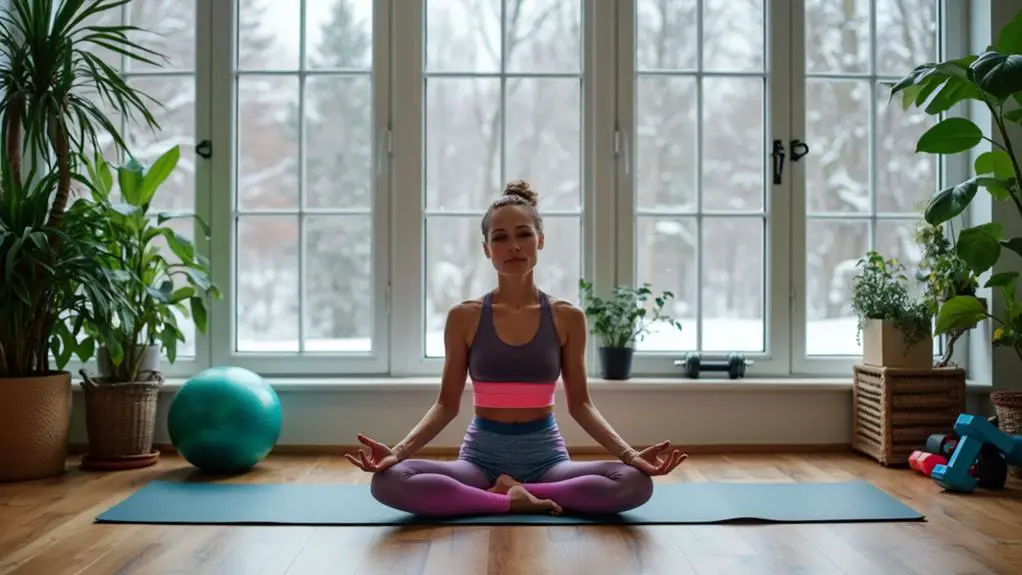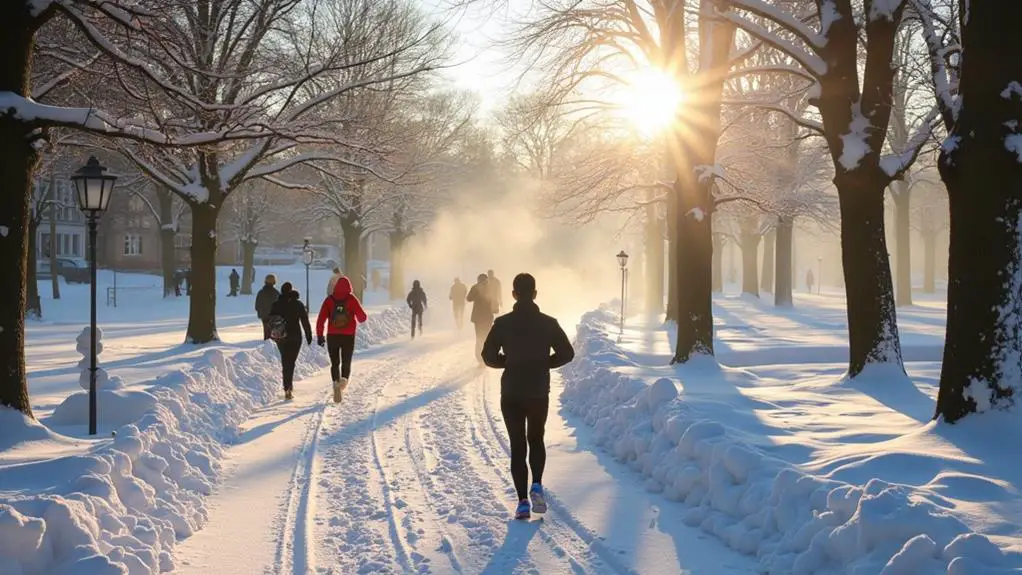The Importance of Staying Active During Winter Months
Staying active during winter is essential for your physical and mental well-being. Regular exercise boosts your immune system, reducing your risk of colds and flu by up to 30%. It also combats Seasonal Affective Disorder (SAD) and improves cardiovascular health. You can engage in indoor activities like mall walking or home workouts, or try outdoor sports such as snowshoeing. Overcome challenges by dressing in layers and setting realistic goals. Aim for at least 150 minutes of moderate-intensity exercise weekly, and consider joining fitness communities for motivation. By maintaining an active lifestyle, you'll reap numerous benefits that extend far beyond the winter months.
Key Takeaways
- Regular winter exercise boosts the immune system, reducing the risk of colds and flu by 20-30%.
- Physical activity combats Seasonal Affective Disorder (SAD) by releasing endorphins and reducing mood disorder risks.
- Winter exercise helps maintain a healthy weight by doubling fat burning and improving cardiovascular health.
- Engaging in 30-45 minutes of aerobic activity 4-5 times weekly maintains both physical and mental well-being.
- Staying active during winter provides opportunities for social interaction and community engagement through group activities.
Winter Exercise Benefits
Winter's chill might tempt you to hibernate, but staying active during the colder months offers a wealth of benefits.
Winter exercise can greatly boost your immune system, increasing white blood cell production and reducing your risk of colds and flu by up to 30%. You'll also combat seasonal affective disorder (SAD) by engaging in outdoor activities that release mood-enhancing endorphins.
Physical activity in winter doubles fat burning, making it an ideal time for weight management. Your cardiovascular health improves as your heart works more efficiently in the cold, leading to better circulation and lower blood pressure.
Moderate-intensity aerobic exercise during winter can even enhance your cognitive function over time. By dedicating 30-45 minutes to exercise 4-5 times a week, you'll reap these benefits while maintaining your mental health and overall well-being throughout the season.
Cold Weather Activity Ideas
You've got plenty of options to stay active during winter, both indoors and outdoors.
For indoor exercise, you can try mall walking, join group fitness classes, or create a home workout circuit.
If you're up for braving the cold, consider outdoor winter sports like snowshoeing, cross-country skiing, or ice skating for a fun and invigorating workout.
Indoor Exercise Options
When the mercury drops, your living room can become your personal fitness studio. Indoor exercise options like yoga, dance, and resistance training offer effective ways to maintain your fitness levels.
You can create home workout circuits using bodyweight exercises such as squats and push-ups, eliminating the need for a gym membership. Don't overlook the benefits of active housework; vacuuming and organizing can help you burn calories while staying warm.
For social interaction and motivation, consider joining indoor sports leagues or activities like bowling or swimming. If you prefer solo workouts, online workout videos and apps provide access to diverse routines, making it easier to stay committed to your fitness goals.
With these options, you'll have no excuse to let winter weather derail your exercise regimen.
Outdoor Winter Sports
Embracing the cold can transform winter into a playground of fitness opportunities.
Outdoor activities like snowshoeing and cross-country skiing offer full-body workouts, improving your endurance while you enjoy scenic winter landscapes.
Ice skating enhances balance and coordination, burning 400-600 calories per hour.
You'll boost your cardiovascular fitness through winter hiking, with trails suitable for various fitness levels.
Don't overlook playful options like sledding or snowball fights, which increase your heart rate and promote physical activity in a family-friendly way.
Even shoveling snow can serve as strength training, burning 200-300 calories hourly while building muscle endurance.
Indoor Fitness Options

As winter settles in, indoor fitness options become essential for maintaining an active lifestyle. You can create a dedicated exercise space at home, incorporating equipment like dumbbells or resistance bands.
Engage in body weight exercises such as squats and push-ups, which require no equipment and offer significant health benefits. Free online workout videos on platforms like YouTube provide diverse exercise options, including:
- Yoga
- Dance
- HIIT
- Strength training
Don't overlook the physical activity potential of housework such as vacuuming or organizing. These tasks can help you stay active while completing daily chores.
For a more structured environment and social engagement, consider joining local fitness classes or community groups. Regular physical activity during winter months is vital for maintaining your health and well-being, so explore various indoor fitness options to find what works best for you.
Overcoming Winter Exercise Challenges
Winter presents unique challenges for maintaining an active lifestyle, but with the right strategies, you can overcome these obstacles. To stay active and reap the benefits of regular exercise, start by dressing in layers. Moisture-wicking base layers and insulating outer layers will keep you comfortable during outdoor activities.
Don't let a busy schedule deter you; even short 10-minute workouts can provide significant health benefits. Embrace enjoyable winter activities like ice skating or snowshoeing to boost your motivation.
When outdoor conditions aren't ideal, turn to indoor alternatives such as home workouts or group classes. Set realistic, incremental fitness goals to maintain commitment throughout the season.
Seasonal Health Considerations

As you maintain your winter exercise routine, you'll want to contemplate strategies to prevent seasonal illnesses and boost your immune system.
Don't forget to address the potential effects of Seasonal Affective Disorder by ensuring adequate sunlight exposure or contemplating light therapy.
Remember to take proper precautions when exercising in cold weather, such as dressing in layers and staying hydrated, to maximize the benefits while minimizing risks.
Winter Illness Prevention Strategies
Seasonal health considerations play a crucial role in winter illness prevention strategies. You can boost your immune system and improve your overall health by exercising in cold weather.
Regular physical activity increases white blood cell production, reducing your risk of colds and flu by 20-30%. Additionally, staying active helps combat Seasonal Affective Disorder (SAD), enhancing your quality of life during shorter winter days.
To maximize the benefits of winter exercise:
- Engage in 30-45 minutes of aerobic activity 4-5 times weekly
- Combine exercise with flu vaccinations for stronger protection
- Choose activities that elevate your heart rate and boost circulation
- Maintain a consistent routine to improve both physical and mental well-being
Combating Seasonal Affective Disorder
Battling the winter blues, many people find themselves struggling with Seasonal Affective Disorder (SAD) during the colder months. Regular physical activity can be a powerful tool in combating SAD.
By engaging in 150 minutes of exercise per week, you can reduce your risk of winter-related mood disorders by 20-30%. The benefits of physical activity extend beyond just improving your mood; it also helps fight fatigue and boosts energy levels.
To maximize the impact, try outdoor activities you enjoy, as exposure to sunlight increases vitamin D intake, essential for mood regulation. Social exercise activities, like group classes or outdoor sports, offer the added advantage of social interaction, further alleviating feelings of isolation.
Cold Weather Exercise Precautions
Braving the winter chill for outdoor exercise requires careful preparation and attention to safety. In cold temperatures, it's essential to wear layers, starting with moisture-wicking materials and ending with waterproof outer protection.
Don't forget proper footwear to prevent slips on icy surfaces. Before engaging in any winter sports league or outdoor activity, perform thorough warm-ups to increase blood flow and reduce injury risk.
When exercising in winter, remember:
- Any activity is better than none
- Aim for at least 150 minutes of moderate-intensity aerobic exercise weekly
- Be aware of signs of hypothermia, such as shivering and confusion
- Consult a healthcare provider if you have heart disease or other health concerns
Maintaining Motivation Year-Round
Maintaining motivation throughout the year can be a challenge, but it's essential for staying active during winter months. To help you stay motivated, set specific, achievable fitness goals and track your progress.
Engage in enjoyable activities like group classes or outdoor sports to make exercise feel less like a chore. Incorporate music into your workouts to boost your mood and energy levels.
Find an accountability partner or join a fitness community for social support and encouragement. Establish a routine with short, manageable workouts, as even brief sessions can provide significant health benefits.
Conclusion
Don't let winter slow you down. By staying active during the colder months, you'll boost your mood, maintain your fitness, and keep your immune system strong. Remember, even small amounts of exercise make a difference. Studies show that just 15 minutes of daily physical activity can increase your life expectancy by up to three years. So bundle up, get creative with indoor workouts, and keep moving. Your body and mind will thank you when spring arrives.







